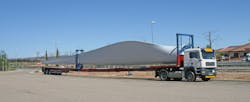Sims prove trucks can maneuver turbines on-site
A reliable and trusted software solution is crucial for confirming that specialized trucks can navigate difficult site access road geometry on any project. Simulating a vehicle’s path provides immediate feedback that might illustrate the need to widen roadways in sharp-radius curves. Visualization might also identify potential problems such as conflicts with road geometry, signage, structures, trees, cut slopes and utilities. This important information in the operators’ hands helps reduce the risks of injuries, damaged equipment, delayed delivery time and increased costs. Vestas Wind Systems, a wind turbine manufacturer, was seeking a partner to analyze vehicle paths of specialized transport truck and trailer configurations.
Within the vehicle libraries of AutoTURN from Transoft Solutions are six specialized vehicle configurations, allowing the creation and simulation of independent rear-steering systems critical to the maneuvers Vestas required in their projects. These include a 19-axle heavy hauler trailer, a wind tower trailer (or Schnabel trailer), a wind blade trailer, a beam transporter I and II and a booster trailer. AutoTURN allowed engineers from Transoft and Vestas to evaluate the swept-path envelopes of both the vehicle body and the cargo on specific transportation routes, potentially preventing damage to the load or surrounding structures.
In February 2012 a series of driving tests were performed in a Vestas works yard. A driving course was built to replicate the critical roadway geometry of the planned access road for the complex terrain required in the project. GPS coordinates from key points on the tractor, trailer and loaded blade were recorded. Using AutoCAD software, the swept path of the simulated vehicle matched the swept path of the field test vehicle accurately, with variances consistently less than 30 centimeters.
“The result from the wind-transport field test gives us confidence,” said Steven Chan, a senior civil engineer at Transoft Solutions, “that these highly specialized vehicles can make these complex turns.”
Three-hundred-sixty-degree turns and figure-eight maneuvers also were performed during the field test to determine the mechanical limitations of the vehicle. These properties were entered into the AutoTURN vehicle model to ensure that simulations were realistic and would not exceed the mechanical limits of the vehicle.
Whenever passersby see one of the massive wind turbine assemblies rolling down the highway, they can rest assured that the truck and trailer can safely make any turn en route to its destination.
